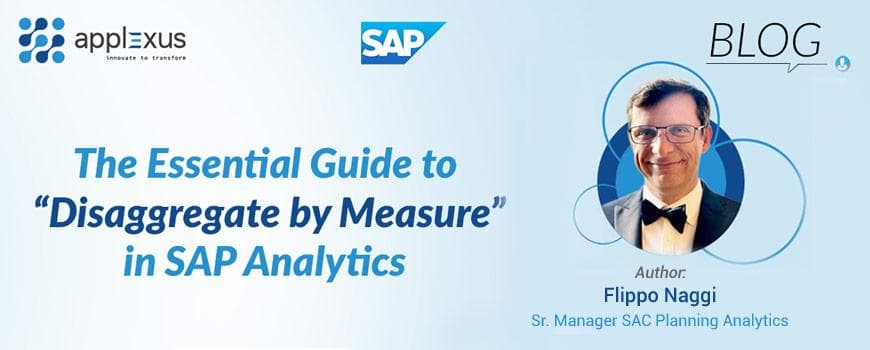Unlock the potential of data with SAP Data Intelligence Cloud
18 August 2022


Michael Godette
Data Management Practice leadMichael Godette is the Data Management Practice lead here at Applexus and has more than 27 years of experience working with SAP solutions. With strong expertise...
Modern enterprises have a complex and diverse data landscape. Approaching it with legacy tools in an orthodox manner does not help to unlock and tap into the data’s full potential. As a result, most organizations fall short of realizing maximum value from the rich data. They fail to extract 360-degree insights and rarely if at all, manage to extract optimum benefits from the data.
47% of organizations say that data and analytics have significantly or fundamentally changed the nature of competition in their industries in the past three years - McKinsey 1
The dispersed and disconnected data assets make it hard to extract useful insights in the right context and at the right time. The lack of - visibility, centralized interfaces, frictionless access, swift data retrieval mechanisms, and other bottlenecks prevent an organization from fully optimizing its data. Businesses lack the capabilities to operationalize data strategically.
Companies on average spend around $14.5 Million on non-compliance problems - Globalscape 2
Currently, organizations are gravitating towards a data management solution that is much more comprehensive. Something that would help their resources connect, access, enrich, and arrange disjointed data assets into informative business insights.
Why Organizations Fail to Unlock Maximum Value from Enterprise Data Assets
Most organizations have a very complex data landscape where most of the data they possess is organized in a row-column format and leveraged to build data marts and data warehouses, and the analytics are run to gain useful insights. However, this framework is cumbersome, laborious, and time-consuming, and often is plagued with errors.
86% of organizations are not making the most out of their data - SAP 3
74% of companies are limited by data complexity and sprawl - SAP 4

A Next-Generation Data Platform from SAP Aims to Resolve the Data Challenges
SAP Data Intelligence Cloud is a comprehensive data management solution: It equips organizations with numerous capabilities that help them to integrate, orchestrate, enrich, and transform the available data. DIC provides organizations a suite of tools to understand, process, and manage data effectively. This integration across the IT landscape will provide users with intelligent and relevant insights near instantaneously.
SAP Data Intelligence Cloud is the cloud equivalent of the on-premises SAP data intelligence. This cloud-based service syncs with the roles and responsibilities of data engineers, data stewards, data scientists, and data architects. Essentially, any user can maximize the data spread across the distributed hybrid landscapes, help to create data warehouses from mixed data, and simplify the management of data streams.
This comprehensive data management solution sits as the data orchestration layer of SAP’s Business Technology Platform. It provides end-to-end data integration and processing capabilities. Plus, collates and analyzes distributed data to provide users with intelligent, relevant, and contextual insights by integrating, enriching, and transforming all the complex data.
DIC empowers an organization to Discover data from the data landscape and its interconnections. Furthermore, it helps to Refine the acquired data by enriching, curating, and reusing data, Govern the data, and helping Orchestrate data using modular data pipelines.
Data Intelligence Cloud (DIC) handles:

With 4 Key Pillars:

Myriad of Capabilities Collated into a Single Platform

- Data Discovery: DIC can identify data from different sources by detecting inherent patterns. With DIC, organizations get to connect to diverse systems and applications to retrieve similar data.
- Data Orchestration: The data orchestration capability within DIC helps to easily orchestrate and execute complex data pipelines in a defined order within an organization. It also defines and executes tasks such as file operations and data flow graphs, allowing continuous and easy movement of all the data sets across an organization.
- Connect, Orchestrate, and Monitor Processes Across Systems: Organizations can build data workflows and schedule them to run at specific times whenever new data comes in to be processed and moved to the target. DIC allows an organization to trigger the execution of process chains in SAP BW, transfer data from SAP BW and SAP HANA, and execute remote jobs in SAP Data Services.
- It also allows extensive monitoring to view, control, and audit the data operations in the data landscape. The monitoring feature provides an overview of activity at the data pipeline level, displays where resources are consumed, and detects failures, allowing the users to perform some debugging to detect flaws in the data pipeline.
- Data Profiling: Using DIC, organizations can conduct a detailed analysis of data sets to acquire a better understanding of all the data available across the landscape. This solution provides a holistic view of the data by capturing the metadata, tallying it with other information such as owner, validation rules, or quality scores, and interpreting the quality and structure of data with other data.
- Data Quality: DIC helps organizations understand the quality of their data and decide where data enhancement and improvement are needed. Organizations can even customize rules to ensure that final data can be trusted to drive successful decisions. Dashboards can also be created using custom tiles to display the results of the data sets, and scorecards or trend groups can be employed.
- Data Preparation and Ingestion: Using DIC, organizations can acquire data from different sources and store it in an easy-to-use spreadsheet interface. The solution makes it easy to acquire, store, and enhance data in a user-friendly manner. Also, data can be moved from multiple sources to a single target, stored, and further analyzed.
- Data Pipelines: DIC’s data pipeline modeler allows organizations to build scalable and flexible flow-based pipelines to process, refine, and enrich data at the source. Users can push down the processing to where the data is stored (i.e., source systems) without moving too much data across the network, with 250+ pre-defined, drag-and-drop operators that allow data injection, data processing, or data integration.
- DIC enables the creation of data pipelines to access, manipulate, migrate, and transform data within the business landscape. In addition, users can build flow-based applications, handle batch jobs, stream Internet of Things (IoT) data, create custom operators for specific purposes, and handle message queues with ease. As a result, data pipelines can increase efficiency.
- Metadata Management: Metadata is the collection of all the information about an organization’s data, such as data source, origin, owner, type, and other attributes. Using DIC, metadata can be managed across a diverse and distributed data landscape. It also allows users to create a repository of the extracted metadata, enable semantic relationships, preview source data in a common format, and thus build a catalog and get insights into an organization’s metadata.
- Machine Learning: DIC also allows users to automate low-value tasks so that data scientists can focus on more value-added tasks. With DIC, all tasks can be managed on a single interface to orchestrate data flows across the organization and configure the underlying data pipeline.
“Data as an Asset” – Infusing Intelligence into Your Data

- Scale. DIC is easy to scale, thus, supporting data assets’ growth. With this solution, organizations can overcome the challenges associated with on-premises storage and avoid running out of space and purchasing more storage hardware.
- With DIC, an organization can reduce expenses because it will have nearly unlimited storage readily available. DIC allows the runtime to be scaled based on the jobs getting executed.
- Centralization. The very nature of the cloud means that users can access the data from anywhere. Instead of relying on scattered and poorly managed data assets, organizations can now leverage a single integrated platform to help unify all the key data assets for easy access by anyone from anywhere in the world.
- Efficiency. The DIC platform empowers every resource. Users who require data can swiftly and seamlessly find, access, and analyze it, leading to better and faster decision-making. Data can be indexed, profiled, and segregated within an organization to discern valuable data assets from insignificant data assets.
- Added Value. DIC delivers added value through advanced automation and reduces the time required to accumulate and process data assets.
- Security. DIC is far more secure than on-premises storage. The high level of data security ensures all confidential and sensitive data backed up to the cloud is protected from outside threats. With encryption, identity and access management, and network vulnerability testing, the data environment is always stable and secure.
- Analytics and Reporting. DIC allows analysis of the data wherever it resides and creates detailed reports and visual representations of an organization’s data elements and the connections between them. Data users can extract quality information quickly and with utmost confidence to help with better decision-making.
- Compliance. The comprehensive metadata management rules help organizations follow global regulatory standards, minimize risks of holding sensitive user data, avoid penalties, and ensure compliance across the business functions. Compliance costs can otherwise limit the amount of investment in innovation and other value-based activities.
Wrapping Up
The data environment in organizations continues to evolve at an unprecedented pace, presenting both challenges and opportunities in every business unit. To stay ahead of the curve, prepare for unprecedented changes, tackle disruptions, and become industry leaders, organizations need to adopt metadata management and transform into future-forward data-driven enterprises.
Data Intelligence Cloud (DIC) offers a platform that equips organizations with impactful capabilities to connect all data users to the right data, at the right place, and at the right time. It empowers them to collaborate with trusted data, in near real-time, and make business-critical decisions for credible insights and better outcomes.
1 Gottlieb J and Weinberg A, September 19, 2019, Catch them if you can: How leaders in data and analytics have pulled ahead, McKinsey, https://www.mckinsey.com/capabilities/quantumblack/our-insights/catch-them-if-you-can-how-leaders-in-data-and-analytics-have-pulled-ahead
2 Systems H, December 2017, The true cost of compliance with data protection regulations, Globalscape,
3 Lintelman L, February 5, 2019, Managing and Integrating Your Complex Data Landscape, SAP, https://blogs.sap.com/2019/02/05/managing-and-integrating-your-complex-data-landscape/
4 Poskitt K, July 15, 2019, SAP Data Intelligence: Enterprise AI Meets Intelligent Information Management, SAP, https://blogs.sap.com/2019/07/15/sap-data-intelligence-enterprise-ai-meets-intelligent-information-management/












